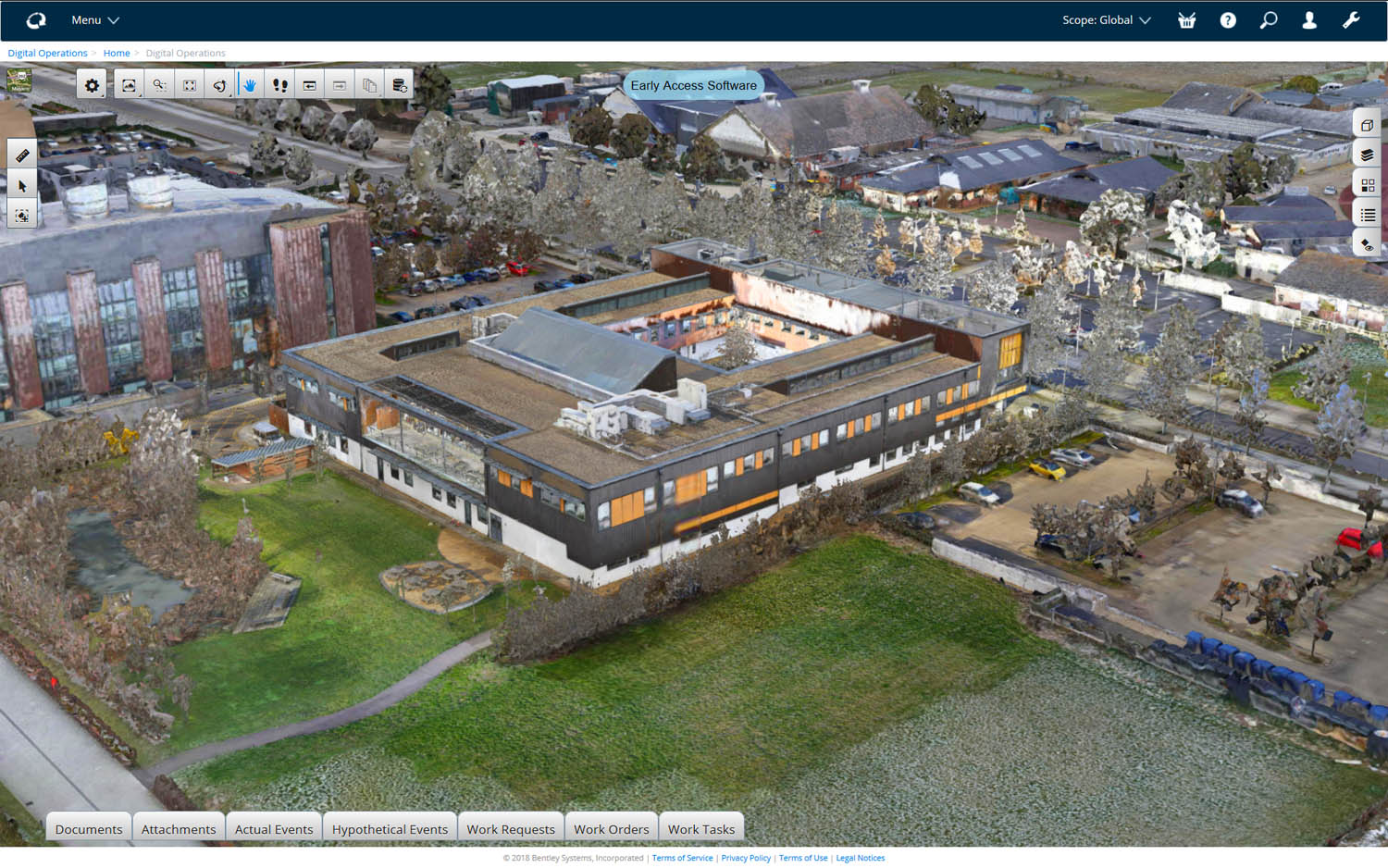Digital twins: the case for open-source
In order to achieve sustainable infrastructure digital twins, it is imperative that you build your systems around open-source technology so the keys to your destiny remain in your hands, writes Keith Bentley, founder and CTO, Bentley Systems
A digital twin is a realistic and dynamic digital representation of a physical asset, process, or system in the built or natural environment.
As was the case with BIM nearly 20 years ago, digital twins are now reshaping the built world in terms of how infrastructure is designed, constructed, and operated.
The industry has always faced challenges managing the volume and variety of data, as well as the varied ways it changes over time. This can be overwhelming for infrastructure professionals, whether their specialty is in project delivery or in operations.
The advent of digital twins has helped the industry advance existing BIMcentric processes by improving data quality and accessibility. Importantly, infrastructure digital twins can be achieved “in place,” without having to disrupt or replace existing workflows or systems.
Regardless of infrastructure type, over time the digital twin of an asset or a project will become both its lifeblood and its central nervous system. That is — it’s going to be really valuable.
We believe that to achieve sustainable infrastructure digital twins, it is imperative that you build your systems around open-source technology so the keys to your destiny remain in your hands.

You are not going to “buy” your digital twins from a single vendor. Instead, you’re going to assemble, build, customise, and evolve your twin from pieces from many vendors, the mix of which will change over time. Each of them will tell you how “open” they are. Only those who are open sourced (meaning you have the ability to use your digital twin and the source code that powers it without a fee) really mean it.
Building the foundation for iTwin.js
When we announced iTwin.js, we described that the foundation upon which it is built is the most open, productive, intuitive, and powerful development environment for capital projects and infrastructure assets, ever.
The iTwin.js library is a comprehensive collection of JavaScript packages that build on the most open, popular, and flexible standards for modern cloud and web development. Though it can be used from any programming language, it is written in TypeScript (my favourite programming environment ever, by far) and leverages open technologies including SQLite, Node.js, NPM, WebGL, Electron, Docker, Kubernetes, and of course HTML5 and CSS. The same codebase can produce cloud services and web, mobile, and desktop applications.
The source code is hosted on GitHub and is distributed under the MIT licence. (N.B. full disclosure – there is a native Node.js module that Bentley builds and distributes via NPM for each platform. It is not open source but is delivered with a right-to-run).
By leveraging these open technologies, we have created the Bentley iTwin platform that is relevant for many different use cases. Our platform handles some important and difficult tasks such as persistence, visualisation, scalability, security, and interoperability. Of course, your digital twins will have different mixes of data sources and features depending on the type of asset.
The goal of an open platform is to allow anyone working on one aspect to easily combine their efforts with people working on other aspects. That means the whole thing doesn’t need to be written all at once and from one vendor.
In the software world there are many data sources. An open platform helps us to combine everything we use with little effort. A good infrastructure digital twin platform should do the same.
By building your platform on open-source technology, you provide your users, and others who will extend the platform, with the ability to change it. They can copy the program source and access their data without paying a licence.
An open-source strategy has worked extremely well in other industries, but it has yet to be fully adopted in engineering, BIM, or CAD. The reason is that there has not been a meaningful platform open enough to allow people to layer on it, and even enable competitors to create solutions that work together with it.
To create an infrastructure digital twin (we call it an “iTwin”), we fuse together many types of data sources. One source is what we call “digital context”—observations sampled or surveyed in the past. Another source is “real-time” or current data, such as IoT sensors, control systems, ERP systems, and emergency response systems.
The data source that makes infrastructure digital twins most challenging is engineering and/or BIM data, because they often represent some future state of the twin. The concept of “future state” is a challenging computer science problem because it is nonlinear (i.e. there can be multiple valid states extant simultaneously). That’s the main reason infrastructure digital twins have never existed heretofore. Obviously all three data sources, past, present, and future, change continuously but with different granularity.
Nonetheless, if you could fuse all those data types, it’s clear that infrastructure digital twins will provide the basis for new applications to improve asset performance, including sustainability, productivity, occupancy, energy, safety, and maintenance. The questions are then: “How do you structure the data?,” “What transaction model?,” “How to visualise past/current/future in a single window?,” and “How do you make the system secure?”
The answers will vary for each data type. If every organisation working on just one part of a digital twin had to solve all those problems on their own, they’d never finish, and nothing would work together.

The answer, like all computer science problems, is to layer on top of a comprehensive but extensible platform that supplies implementation of the pieces. For that platform to be both technically and economically feasible, I argue that it must be an open-source project sponsored by a profit-motivated organisation. I offer iTwin.js from Bentley as that platform. If you feel there’s some part of it that you would rather work differently, you can change either by forking our code, or, hopefully, by generating pull requests to our repositories on GitHub. That way the ecosystem strengthens itself.
The purpose of an open, scalable, vendor-agnostic platform is to enable an ecosystem of developers to create and bring to market solutions that solve real infrastructure problems by leveraging digital twins.
Over the past few years, we have seen this ecosystem of user organisations, strategic partners, and third-party developers grow. All who work with iTwin.js, and the Bentley iTwin platform, are focused on building solutions to tap the vast potential of infrastructure digital twins.
One company developing on the iTwin platform is Digital Energy. It focuses on solving complex value chain problems by embedding efficiencies in artificial intelligence solutions for industrial planning, supply chain, and work execution. Its application, ODIN Safety, helps asset owners to predict and manage real-time worker health and safety conditions for warehouses and the process industry.
The app synchronises and visualises data including 3D engineering, artificial intelligence-powered health, safety, environment (HSE) data and IoT to better predict what will happen, where, and when to enable safe and prioritised operations.
“As a developer of novel digital AI advisors to asset heavy industries, the ability to portray insights and analytics in real time on a digital twin makes adoption faster and impact for clients clearer,” said Dr. Morgan Eldred, founder and chief ventures officer, Digital Energy. “Within ODIN Safety, the digital twin shows the evolution in potential risks at various locations enabling clients to better intervene and prioritise efforts using 4D visualisation of risk and heat maps of high-risk areas. The Bentley iTwin platform enables open, scalable, and quick application development that provides an incredibly powerful way to bring complex context to organisations, teams, and people.”
At Bentley, we are dedicated to having developers, like Digital Energy, engage, share, and learn from each other. We created a partner program for software vendors and systems integrators to get support and guidance to help them innovate, accelerate, and scale their development efforts to deliver digital twin solutions. Learning and expanding the knowledge in the platform is important to us and to our users. Through accreditation, developers gain an understanding of the basic principles and components of developing software applications including data synchronisation and federation, visualisation, and querying iTwin data.
Empowering people to do more
We developed the Bentley iTwin platform to be as open as we can make it. People now use it to solve problems that have nothing to do with Bentley Systems. We did not do this to be charitable. We did it because we believe that as our platform is leveraged by third parties in creative ways, then we will be relevant when they succeed. We are fostering an ecosystem of innovation that will grow around a common set of source codes and data types that can be defined with open-source tools that are built on open standards.
In my opinion, as an industry the opportunities for improving outcomes enabled by infrastructure digital twins are vastly larger than at any point in the 37 years I’ve been in this business. At Bentley Systems, we’re excited about that potential, but we don’t aspire to be “the infrastructure digital twin company,” since it’s clear there will be need for many hundreds of such companies. Instead, we intend to be the “infrastructure digital twin platform company” working in an ecosystem of innovation along with partners leveraging that platform. We think this will create a world where infrastructure digital twins really can improve the quality of life for everyone on the planet.
Data for digital twin development
When we’re asked about the data that comprises a digital twin, our answer is that the types of data vary with the use case. But getting started does not have to be difficult.
In the simplest example you might just want to go out and take pictures or LiDAR with your mobile device, then turn that into a digital mesh of your asset. That’s a wonderful start, because while that mesh may not start as very “sophisticated,” it is very accurate. The process provides you with the digital context for creating a digital twin.

For engineering/BIM data we’ve created free “connectors” that synchronise with the most popular formats (e.g. .dgn, .dwg, .rvt, .ifc, etc.). There are also APIs for others to create their own connectors. Since a single iTwin may hold data from an eclectic mix of connectors, you can continue to design with your current set of authoring tools and seamlessly synchronise with multidiscipline, multivendor, and multi-organisation infrastructure projects.
The post Digital twins: the case for open-source appeared first on AEC Magazine.
Powered by WPeMatico
